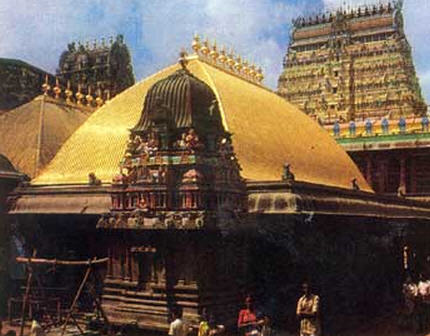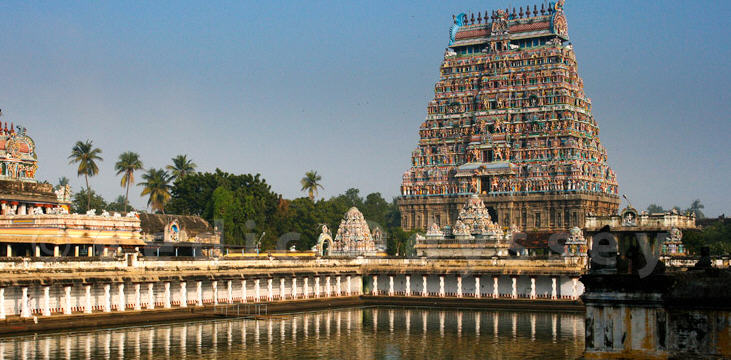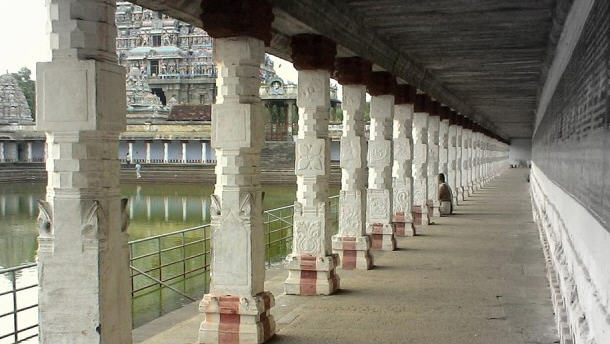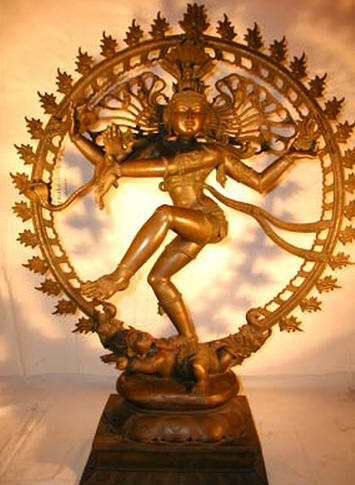This is the temple dedicated to Lord Shiva found in his famous dancing pose with one leg in the air and consisting of four arms. The temple is honoured to Lord Shiva in his aspect of Nataraja or the form of the celestial Dancer. Lord Shiva is seen in the Ananda Tandavam dancing position.
Chidambaram is the seat of Lord Shiva as the cosmic dancer Nataraja (Ananda Tandava pose ; the Cosmic Dance of bliss). The Deity of Nataraja is enshrined in the Chit sabha. Behind this Deity, is a black screen, which is considered to cover the Akasa Lingam. There is no Lingam, but we are made to believe that there is an invisible Lingam, with golden bilva garlands, i.e stressing the belief that there is everything in nothing. There are five silver plated steps to reach the Chit Sabha, representing the Panchakshara mantram – Na ma si va ya. The embossed images of the saints Vyagrapada and Patanjali, are to be seen on the doors. Both these saints had been blessed with the sight of the cosmic dance of Shiva. Lord Vishnu also is said to have witness this scene. The sanctum of Sivakama Sundari lies to the left of Natarajar Sannidhi. The images of Ratnasabhapati (Nataraja of Ruby), the Spatika Lingam of Chandramauleeswara, Swarnakarshana Bhairavar, Mukhalingam are also to be found in the Chitsabha.
Chidmabaram is also called akasha sthala as here lord shiva lingam is made of Akasha element. Other 4 elements of which Shivalingam is are either Earth (Generally seen), Fire, Air or Water. https://www.youtube.com/watch?v=ersC2KHxV08
(Located in five south Indian temples, the Bhuta Lingams are said to be places where Shiva manifested himself as the natural elements. The temples and their respective elements are : a) Chidambaram or Chidambareshwar: ether (akasa), b) Sri Kalahasti or Kalahastishwar: wind (vayu), c) Tiruvanaikka/Jambunath / Jambukeshwar near Srirangam: d) water / jala, Kanchipuram / Shivkanchi: (prithvi) earth, and e) Tiruvanamalai (Arunachalam): (Agni) fire.)
The temple was in vogue for centuries, but its known glory in records begins with the visit of Hiranya Chakravarthi of Kashmir around 500 A.D. The king is said to have been cured of his leprosy with a single dip in the temple pushkarini, Sivaganga thirtham . The four great Shaiva acharyas Appar, Sambandar, Sundarar and Manikkavachakar are connected with this holy temple and produced master pieces eulogising their respective paths.
In the 10th century, the Chola king Parantaka I made rich endowments to the temple, besides providing a golden roof to the Karuvarai. The Cholas, who were devout Saivites made improvements to the temple maintaining its glory. The north Gopuram was built by Krishnadeva Raya and the east Gopuram was built by Sundra Pandyan.
The temple is built of granite on 39 acres of land in the heart of the city. It is surrounded by massive walls with four big tall gopurams in four directions and a big tank called Sivagangal tank measuring 175×100 feet towards the North. The North & South gopurams are 160feet high. The 108 dance postures as seen in the Natya Sastra are sculpted in these towers. It has five principal sabhas known as Kanakasabha, Chit sabha, Nritya sabha, Deva sabha and Raja sabha.
The Deity of Nataraja is enshrined in the Chit sabha.
In the Kanaka sabha (golden hall) lying adjacent to the Chit Sabha, poojas are offered. The ceiling of these two sabhas are gold plated.
The Nritya Sabha, which is richly sculpted in the form of a chariot drawn by horses houses the images of Nataraja in Urdhava Tandava pose, image of Sarabheswara.
The Deva Sabha is a spacious hall meant for the celebration of important festivals and houses the festival images of the Pancha Murtis (Somaskandar, Parvati, Vinayaka, Subramanya and Chandikeswara) and other deities.
The Raja sabha measuring 103 metres by 58 metres is housed in a 1000 pillared hall in the outermost prakaram. Tradition holds that Sekhizhar recited the Peria Puranam here.
Chidambaram is also called as Thillai Vanam because previously this area was filled Thillai trees. (vanam meaning forest and thillai trees – botanical name Exocoeria agallocha, a species of mangrove trees – which currently grows in the Pichavaram wetlands near Chidambaram).






